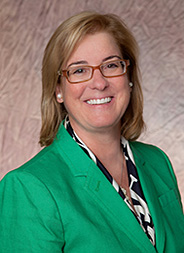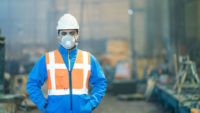 Kathy A. Seabrook CSP, CFIOSH, EurOSHM:
Kathy A. Seabrook CSP, CFIOSH, EurOSHM:
Greetings and Welcome to the “Standards and the Global Supply Chain” event hosted by ANSI. Today I would like to spend some time and “Connect some Dots” on Supply Chain accountability, the Market Economy, Sustainability or Corporate Social Responsibility (CSR as it is known), Materiality reporting – AND the ISO 45001 management system standard for workplace safety and health.
RISK is the common thread connecting supply chain accountability, the Market Economy, Sustainability, Materiality reporting and ISO 45001 -- AND all of these risks can have an impact public policy. This interconnectedness of RISK impacts society, the economy and trade, an industry, an organization, its reputation and brand, its shareholders, business processes, product and service delivery capability, its workers and its supply chain.
As we heard from Vic, the premise of a management system standard is to set out requirements to establish, implement, maintain and continually improve a system to manage RISK. Current Management systems standards you may be familiar with are environmental (ISO 14001), quality (ISO 9001), Food Safety (ISO 22000) and Consumer product Safety. ISO has over 70 management systems standards, covering everything from energy to Asset management. The ISO 45001 standard is focused on the management of an organization’s Occupational safety and health (OH&S) risk-- that is Worker Safety and Health.
I would like you to hold this thought on managing Occupational safety and health or OH&S risk, because we are going to come back to this in the next few minutes.
Let’s continue to “connect the dots” on Risk and an organization’s supply chain. You will have seen and heard news of the garment fires and Rana Plaza building collapse in Bangladesh two years ago. One fire took the lives of 102 people who were trapped in a building where fire blazed around the workers. The Rana Plaza collapse took 1,129 lives. Investigations of the garment fires found the basic provision of adequate emergency exits-- did not exist. And due to concerns of theft by the workers, the exits that did exist were locked. There was no way out for the workers caught in the Blaze. In the case of Rana Plaza, the building and company owners knew there was issue with the integrity of the building but chose not to provide a safe place of work for those in their employ. The Alliance for Bangladesh Worker Safety and the Accord on Fire and Building Safety in Bangladesh were formed in the aftermath of these incidents to promote better life safety for those working in Bangladesh. The fire life safety inspections organized by these groups are an important feedback mechanism for continual improvement and they are part of the ISO 45001 systems approach to managing the OH&S RISKs of injury, ill health and/or death to workers. There were multiple causation factors that led to the collapse and fires.
Proactively identifying OH&S RISKs - before an incident occurs-and assuring controls are in place can help to minimize or eliminate these causation factors in the future. This is a sustainable, management system approach and is the basic premise of ISO 45001.
Let’s continue to “connect the dots” on the theme of RISK. There are two drivers impacting change by some organizations to be more accountable for their supply chain-- THE MARKET Economy and SUSTAINABILITY reporting-- and they are closely tied. The investment community and organizational stakeholders are driving market demand for more transparency from the organizations they invest in. To give you a Business perspective, the UN Global Compact and Accenture conducted a CEO Study on Sustainability about a year an a half ago. They surveyed 1,000 CEOs from around the world and 93% of these CEOs stated “Sustainability is important to the future success of their business.”
Sustainability reports published annually or biannually by publicly traded companies are increasingly disclosing supply chain and worker safety and health risks that are material to their organization. Globally, the Market which includes the investment community and other organizational stakeholders, has embraced the voluntary Global Reporting Initiative’s (GRI) Framework for reporting disclosures in Sustainability reports. Over 95% of the companies on the Dow Jones Sustainability Index now meet the reporting requirements of the GRI Framework. Some of these companies are now moving to towards integrated reporting, which combines their sustainability and financial performance into one report. It is important to note Occupational safety and health performance is one of the reporting or disclosure requirements in the GRI Framework. The Center for Safety and Health Sustainability has been working to influence the OH&S GRI Framework requirements so they are more proactive and aligned with recognized management systems thinking.
The most recent version of the GRI Framework focuses on supply chain accountability and materiality disclosures. What this means is depending upon the industry sector, the supply chain and nature of risk and operations, OH&S risks may be identified as material to an organization’s financial condition and operational performance – AND therefore must be disclosed or reported to shareholders as a requirement by the US Security and Exchange Commission. This is where the markets-sustainability, public policy and ISO 45001 converge.
In ISO 45001, an organization considers its external issues and the needs and expectations of interested parties to determine its OH&S risks. An example of this is sustainability performance. In this case, the interested party is the investment community and the external issue is transparency on OH&S performance in the Sustainability Report. Since OH&S performance and materiality reporting are becoming expectations of the investment community, this external issue impacts the Organization’s ISO 45001 OH&S management system. Taken a step further, if the OH&S risk is determined to be material to the organization’s financial condition and operational performance it should be reported. Saving worker’s lives and providing safe working conditions also pays off in the health and sustainability of the global supply chains themselves. Treating OH&S RISK as material to the viability of a company –or an industry—also prioritizes worker safety and health initiatives.
Owens Corning is a US manufacturer of building materials and has identified 22 medium-high materiality topics in their sustainability report, and OH&S risk (employee safety and Health) is one of them. This is a trend to watch. The NGO Sustainability Accounting Standards Board (known as SASB) is chaired by Michael Bloomberg with Mary Shapiro (former chair of the SEC) as vice chair. These are two powerful influencers in the investment community and policy development arena. They are overseeing the development of SASB Materiality Maps™ which identify materiality issues on an industry-by-industry basis. Materiality Maps have been created for the Financial services, Technology and Communications, transportation, mining and the oil and gas industries to name a few. SASB‘s goal is to get companies to focus their sustainability strategies on the most important issues and to understand the metrics that underpin each materiality issue that is reported. They are also encouraging Investors and other market participants to use the SASB Materiality Map™ “to analyze portfolio exposure to specific sustainability risks and opportunities represented by each material issue.” In the end, the market will determine the future of SASB’s influence.
Let’s bring us back full circle to ISO 45001 and how it can inform and play a role in creating solutions that cross borders. First of all, ISO 45001 is management tool for organizations. While the scope of ISO 45001 is not intended to include supply chain workers, an organization can choose to leverage the ISO 45001 management systems approach as a solution to identify, control and continually improve opportunities to reduce or eliminate worker safety and health RISK to workers in the supply chain.
The American Society of Safety Engineers (ASSE) is the Administrator of the US Technical Advisory Group to ISO 45001. It is under the leadership of Tim Fisher who is the ASSE Director of Practices and Standards that we meet the administrative requirements of ANSI and ISO.
In closing, Vic and I like to thank Scott Cooper for his visionary work in bringing us together today to engage in dialogue around possible cross border solutions on global supply chain initiatives.
Seabrook is Chair of the Center for Safety and Health Sustainability, a global body of occupational safety and health (OSH) professionals that works with businesses, NGOs and governments worldwide to embed OHS firmly in the sustainability agenda.


